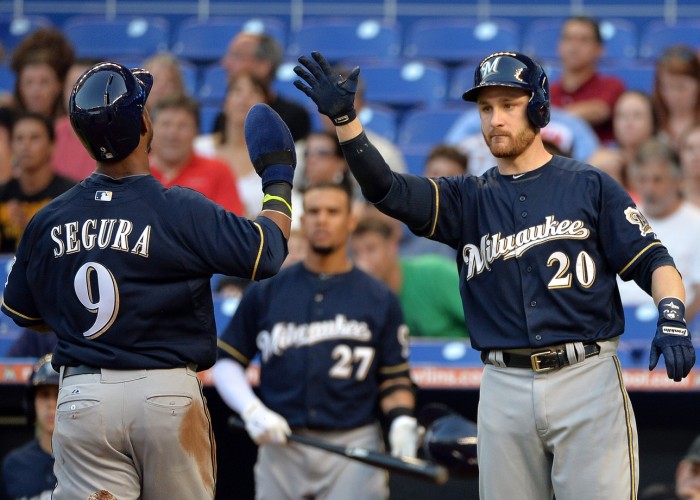Spring training has now officially begun (yay!), and Jonathan Lucroy remains a member of the Milwaukee Brewers. Despite his public comments this offseason about not wanting to be a part of a rebuilding situation, the Brewers’ starting catcher remains a key part of this rebuilding organization. The question therefore remains: How long will that be the case?
His actual quotes to Tom Haudricourt are worth revisiting. He never demanded a trade outright, and he was careful to emphasize that he would be playing hard and trying to win even if the Brewers didn’t trade him. And while that may seem to be an obvious statement, professional sports are littered with examples of players simply refusing to play for an organization of which they no longer wish to be a part. Thus, while Lucroy may be unhappy that he isn’t currently poised to contend for a World Series in 2016, he appears content enough to play the good soldier until the Brewers do decide to move him.
Lucroy’s status in baseball’s catcher rankings is a bit dubious; however, the favorability of his contract is not. Milwaukee only owes him $4 million this year and can exercise a $5.25 million club option for 2017, which would be a bargain for a backup, much less a starting-caliber catcher who has an All-Star ceiling. This year-plus of team control makes him a valuable asset and allows the Brewers to be patient. After all, as long as the team that acquires him does so before the beginning of the 2017 season, he would be eligible for the qualifying offer.
However, his aforementioned 2015 season is the biggest factor as to why he wasn’t moved this past winter. In the three previous seasons, Lucroy appeared to have established himself as one of the game’s premier catchers, even garnering some MVP hype in 2014. But in 2015, he regressed both offensively and defensively. His TAv tumbled to .254 — his first below-average mark since 2011 — and his framing metrics were the worst of his career. The hows and whys of this have been covered ad nauseum on this site already (see Julien Assouline’s breakdown of his defense here and Ryan Romano’s analysis of his contact pattern here), so there is no need for me to rehash that information.
It is significant data when considering why Lucroy remains on the team, though. I have no interest in playing GM and pretending that I know what offers the Brewers have entertained for their starting catcher. Any leaks regarding his trade market are only made public when one of the sides has an ulterior motive for doing so, and David Stearns has earned the benefit of the doubt this offseason when it comes to properly valuing his assets. He’s been aces.
With that being said, though, my idle speculation is that the Brewers are probably valuing Lucroy the way they would have after 2014, and clubs who are calling are trying to get a discount. Realistically, were this not the case, it’s difficult for me to imagine a scenario where Milwaukee would not have already made a deal. Each game Lucroy plays in a Brewer uniform makes him less valuable to the team that would acquire him, so if the Brewers believed they could maximize their return this offseason, a deal would have made sense.
This, then, indicates that there are two factors that would affect Lucroy’s trade status: (1) another team’s injury woes, and (2) Lucroy’s performance level.
Injuries can happen at any point during the season, even during spring training. Any team that may have thought it was set at catcher could lose its starter to a serious injury and become desperate. The Brewers probably aren’t relying exclusively on this — it’s too dependent on outside factors — but it remains a distinct possibility this month. Were a contending team with just one catcher (like Houston, for example, who were linked with Lucroy this offseason) to suffer a devastating injury early in the season, Milwaukee would have to be that team’s first call.
The other, more concrete, issue is Lucroy’s performance. If we assume the hypothetical from above about what sort of offers the Brewers were receiving, then the club has to be counting on a bounce-back performance from him this season, or even obvious signs of life this spring. If other teams are concerned that he may not be the player he was in 2014, a strong start to the season would give Stearns ample ammunition in any negotiation. On the other hand, a disappointing first few months could force the Brewers’ front office to lower their asking price.
An injury that forced a contending team to get desperate would be unpredictable, and if one happened, it could unexpectedly alter the timetable for a Lucroy trade. Barring such an occurrence, though, I would not expect Lucroy to be dealt until the trade deadline or next winter. Presumably, if teams are concerned about what kind of player he projects to be at this point in his career, they would want at least a few months of data before solidifying their opinion.
All of this is to say that because Jonathan Lucroy has not been dealt yet, I expect him to remain a member of the Brewers until at least the end of July. He remains a quality player, but the fact that he hasn’t yet been traded indicates that there is a disconnect between what the Brewers are asking and what they are hearing. The Brewers have opted to be patient and wait for an offer they feel they can’t turn down. And with two full years until Lucroy is a free agent, they can afford to wait.
